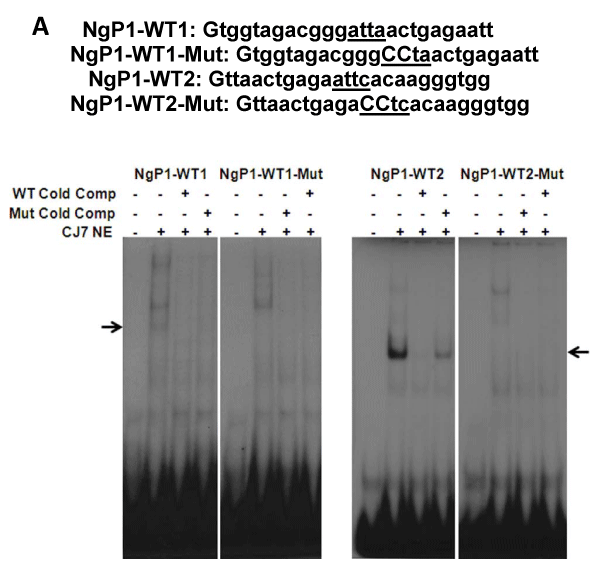 (A) Sequence of the Nanog motif (underlined) containing
NANOG proximal promoter oligonucleotides used as probe. Mutant (Mut)
oligonucleotides have their binding motifs disrupted as shown in capital
letters. Oligonucleotides were annealed to their antisense strands and labeled
with [γ-32P] dCTP using Klenow by filling the G at both ends of the probe.
Unlabeled oligonucleotides of the WT and Mut sequences were used for
competitive binding. Binding was tested using nuclear extracts of CJ7 ES
cells. Protein-DNA complexes of the resulting from Nanog binding is shown
by arrow mark in the WT probes, whereas these shifts were not observed
with the mutant probes. Unlabeled mutant oligonucleotides were also not able
to compete off the binding resulting from the WT probes.
(A) Sequence of the Nanog motif (underlined) containing
NANOG proximal promoter oligonucleotides used as probe. Mutant (Mut)
oligonucleotides have their binding motifs disrupted as shown in capital
letters. Oligonucleotides were annealed to their antisense strands and labeled
with [γ-32P] dCTP using Klenow by filling the G at both ends of the probe.
Unlabeled oligonucleotides of the WT and Mut sequences were used for
competitive binding. Binding was tested using nuclear extracts of CJ7 ES
cells. Protein-DNA complexes of the resulting from Nanog binding is shown
by arrow mark in the WT probes, whereas these shifts were not observed
with the mutant probes. Unlabeled mutant oligonucleotides were also not able
to compete off the binding resulting from the WT probes.(B) Sequence of the Zfp281 motif (underlined) restored to the mouse sequence of the Nanog promoter. Shift observed by incubation of the Zfp281-site restored probe incubation with CJ7 nuclear extract (indicated by arrow) was not observed by the human WT probe. The unlabeled human WT probe was also unable to compete off the shift resulting from the mutant probe.